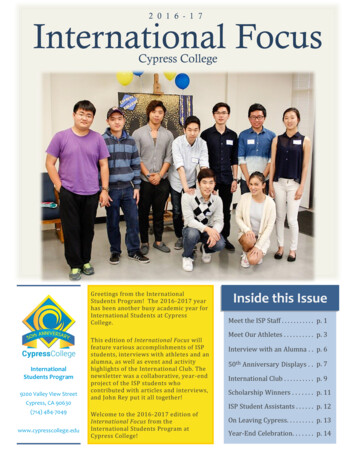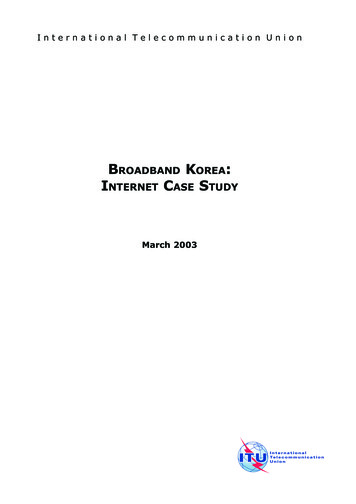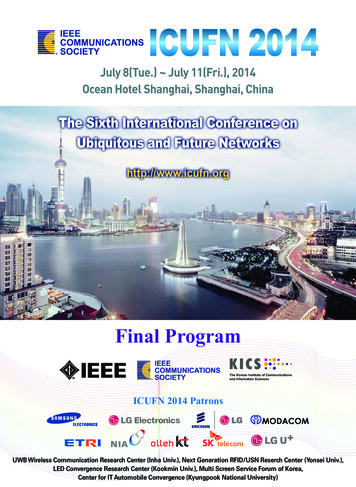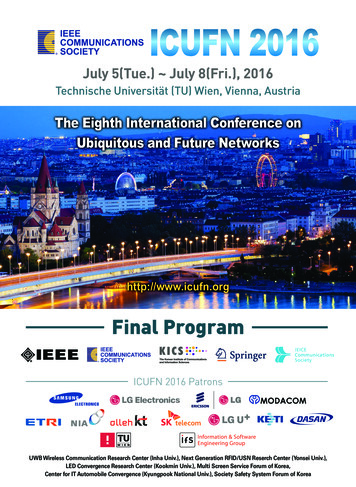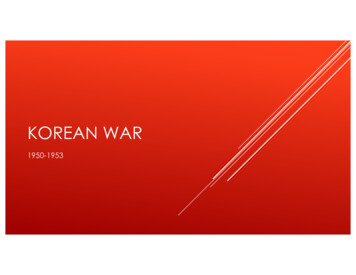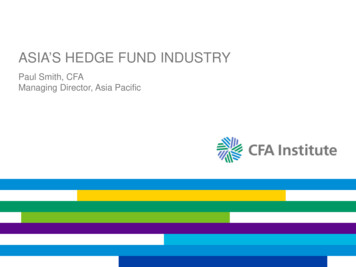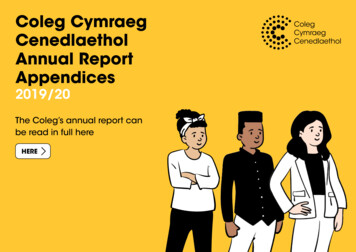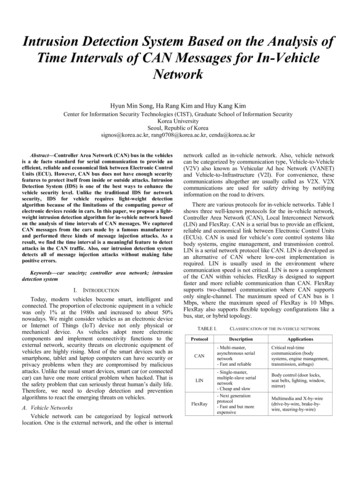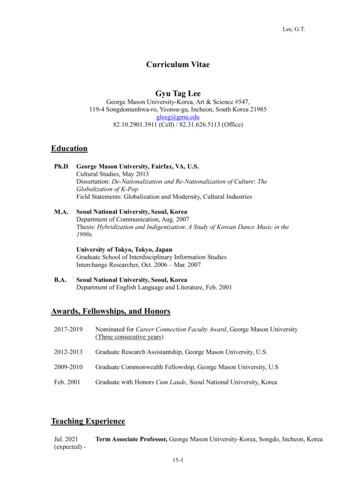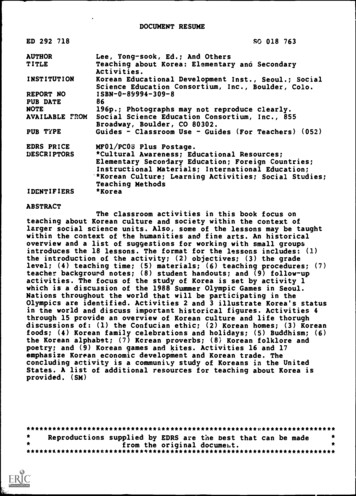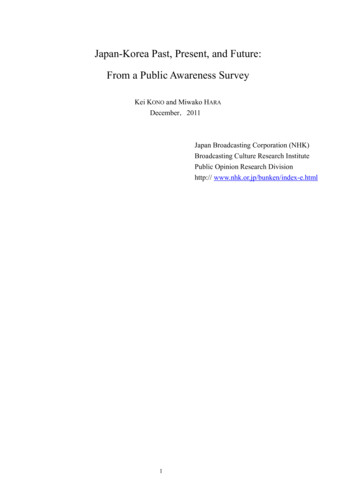
Transcription
Japan-Korea Past, Present, and Future:From a Public Awareness SurveyKei KONO and Miwako HARADecember,2011Japan Broadcasting Corporation (NHK)Broadcasting Culture Research InstitutePublic Opinion Research Divisionhttp:// www.nhk.or.jp/bunken/index-e.html1
August 2010 marked the 100th year since Japan’s annexation of Korea (1910–1945) (see Figure 1).A joint opinion poll was conducted in 2010 by NHK and KBS, public service broadcasters in theirrespective countries, using the same survey method and asking the same questions. The purpose ofthe event was to make a comparative analysis of the survey data and make the findings widelyknown to the public in Japan and Korea (Republic of Korea). Major survey items included basicattitudes toward life (view of the family, concerns in life, purposes of life, etc.), degree of contactwith the other country’s popular culture, perceptions of the other country, and prospects for thefuture of Japan-Korea relations.Figure 1. ChronologyYearEvent1905Korea becomes a Japanese protectorate1909Assassination of Ito Hirobumi by An Jung-gun1910Japanese annexation of Korea1945Korea becomes independent after the end of World War II1948Republic of Korea (ROK) established. Syngman Rhee administration inaugurated.DPRK (North Korea) established. Kim Il-Sung becomes General Secretary1950Outbreak of the Korean War1951San Francisco Peace Treaty1953Ceasefire of the Korean War1965Treaty on Basic Relations between Japan and ROK (normalization of diplomatic relations)1973Kidnapping of Kim Dae-jung1980Gwangju - Democratization Movement1984President Chun Doo-hwan’s visit to JapanEmperor Showa expresses regret over “unfortunate past”1987Large-scale pro-democracy demonstrations in 38 cities and counties in ROKBombing of KAL airliner1988Seoul Olympics1991Former “comfort woman” speaks out against the Japanese government1993Suspicions of North Korean development of nuclear weapons ariseROK opens borders to Japanese for tourism without visas.1995Prime Minister Tomiichi Murayama’s statement expressing remorse and apology over the colonialrule of Korea1997Financial crisis in ROKKim Jong-il becomes General Secretary in DPRKKim Dae-jung administration inaugurated1998ROK lifts ban on Japanese pop culture, liberalizing it in phases (4th phase in 2004)1999Japanese film Love Letter released in ROK2000ROK film Shiri released in JapanROK-DPRK summit meeting2001ROK protests against the Japanese education ministry’s certification of Atarashii rekishi kyokasho(New History Textbook)Prime Minister Jun’ichiro Koizumi visits Yasukuni Shrine2002FIFA World Cup jointly hosted by Japan and ROKPrime Minister Koizumi visits Pyongyang. Kim Jong-il expresses apology over abduction of Japanesecitizens2003ROK television drama Winter Sonata broadcast on NHK BS, a major part of the “Korean wave” inJapan2004Broadcasting of Japanese films on terrestrial television and of Japanese television dramas on CATVbecomes possible in ROK2005“Takeshima Day” established by Shimane prefectureJapan opens borders to Koreans for tourism without visas.2008Lee Myung-bak administration begins2009Democratic Party of Japan takes power in Japan2010ROK naval patrol ship-sinking incident (March 26)2
This was the first opinion poll ever conducted jointly by NHK and KBS. Each of the broadcastersorganized a survey team made up of members from news reporting, program production, and otherfields. The NHK and KBS teams exchanged views via meetings and email, and reached agreementsregarding survey methods, schedule, and content of the survey. NHK and KBS utilized the findingsof the survey on their news, debate, commentary, and other programs.Here let us first outline the sampling method and other survey details and then analyze thesurvey results to illustrate Japanese and Korean lives and social awareness, and how they view eachother.In 1991 and 1999 NHK conducted a face-to-face interview survey targeting Japanese andKoreans.1 As many as possible of the questions asked then were incorporated into the 2010NHK-KBS survey, and findings regarding these questions from NHK surveys will also be introducedin this report.Survey FrameworkFor the 2010 survey, Japan and Korea adopted the same survey period, method, and population , butdiffered in sampling method (Figure 2). In Japan the Basic Resident Register was used for sampling,but such a resident register or list could not be used in Korea, where lists of households kept by theban (traditional local unit of households) and villages are no longer accessible.Figure 2. Survey OutlinePeriodJune 26 (Sat.)-July 4 (Sun.), 2010MethodFace-to-face interviewPopulationPersons aged 20 and over nationwideStratified, two-stage, random sampling from the Basic ResidentJapanRegister2,400 (12 people 150 sampling points)SampleStratified, three-stage sampling(Area sampling)(samples selected using birthday method and quota method)ROK1,000 (average10 people 100 sampling points)Valid responsesJapan1,473 (61.4 percent)(Response rate)ROK1,000Let us look at how the sampling was carried out in Korea. The random-walk sampling using theproportionate quota approach was adopted; i.e., quotas by region, gender, and age werepre-established so as to reflect appropriate percentages for the whole nation.First, a quota proportionate to the size of population was assigned to the provinces andmetropolitan cities that are Korea’s largest administrative units. Next, at the first stage of sampling,ban and villages to be the ultimate fieldwork points were systematically selected. At the secondstage, interviewers went to the points selected at the first stage and visited households at evenlyspaced intervals. At the third stage, they selected as a sample a person who was 20 years old or overwith the earliest birthday in the year in each of the selected households.The survey was first carried out until the responses reached 70 percent for each sample, andthen, to cover shortage in the target number of samples for each region further respondents by3
gender and age were sought out as needed and surveyed.While stratified random sampling was conducted up to selecting the survey points, a quotaapproach was then used in selecting survey respondents. Strictly, therefore, the sampling was notrandom sampling, but when survey results were compared with those of Japan, the statistical testwas performed as random sampling.1. Life and Social Awareness in Japan and Korea(1) Life Credos and Civic ConsciousnessLet us first look at basic characteristics of Japanese and Korean people concerning objectives in lifeand civic consciousness. Regarding goals of daily life, respondents were asked to select the onefrom among the following four items that was most applicable to their situation:Enjoying life freely one day at a time (enjoyment)Gradually building an abundant life in accordance with a clear-cut plan (advantage)Spending each day in a happy atmosphere with the people closest to me (affection)Cooperating with others to make the world a better place. (justice)These four items represent four value categories centered on two axes: whether emphasis is on thepresent or future and whether emphasis is on the self or other.2Among Japanese “affection” comes in first at 43 percent while among “enjoyment” and“advantage” are equally matched, at 36 percent and 37 percent respectively, with the “affection”group half the size in Japan. “Justice” is very low for both countries, each at 6 percent (Figure 3).Figure 3. Life Credos nFuture-oriented46%ROK
Classified on the two-axis model of values, we can say that in terms of whether people arepresent-oriented (“enjoyment” or “comradeship” “affection”) or future-oriented (“advantage” or“justice”), both in Japan and Korea more people are present-oriented. As for whether people areself- oriented (“enjoyment” or “advantage”) or society-oriented (“affection” and “justice”), it isnotable that as many as seven out of every ten Koreans are self-oriented.By gender and age group, “affection” ranks highest for any group in Japan; especially amongwomen in their 50s and under, one out of two displays “affection.” In Korea, there is littledifference in “enjoyment” among age groups while among men in their 30s and under many—oneout of two—are “advantage” oriented (Figure 4).Figure 4. Life Credos (by gender and age 210420s-30s40s-50s60 and over20s-30sROKMen493537660 and 7020s-30s40s-50s60 and over20s-30s40s-50s60 and overRegarding civic consciousness, four models of living were offered on the basis of degree ofsocial involvement and degree of emphasis placed on private life, and respondents were asked toselect the one that was most applicable to their situation (Figure 5). In Japan,an overwhelminglyhigh proportion (46 percent) think that “within the scope of my own life, I work with others and dowhat I can to make a better world” (private life-oriented public citizen). In Korea, such privatelife-oriented public citizens make up around 30 percent, so do people who think, “I follow the rulesand do my best not to disturb those around me” (harmony-oriented private citizen). In regard to the5
other two models of living, “I think about the needs of society and work with others to make abetter world” (society-oriented public citizen) and “my highest priority is the welfare of myself andmy family; I try not to involve myself with the society around me” (self-oriented private citizen),Korean figures are nearly double the Japanese figures in both cases.Figure 5. Civic Consciousness ed public citizenHarmony-oriented private citizenNone of the above112Private life-oriented public citizenSelf-oriented private citizenDon’t know, N.A.(2) Awareness of One’s CountryWhat characteristics do people display in Japan and Korea regarding pride in their country andpatriotic feeling?Pride in One’s Country: “Outstanding culture and traditions” selected by most in both countriesRegarding their own country the respondents were asked to select from a list of eleven items asmany as they thought describe what aspects of their country make them proud. “Outstanding cultureand traditions” was selected by most in both Japan and Korea (Figure 6). The second and thirdplace selections in Japan are “public peace and order is good” and “abundance of nature” and inKorea “abundance of nature” and “family is highly respected.”6
Figure 6. Pride in One’s Country (multiple answers; overall)56%Abundance of nature526564Outstanding culture and traditions44Outstanding education and technology2512Many deeply religious people17Freedom and rights of our people areguaranteed402243Material affluence amid which one can obtainalmost anything1527Family is highly respected462022People treasure the places from which theyoriginally came61Public peace and order is good1310People from other countries are respected644The younger generations are sincerelyconcerned about the future of the countryOtherNothing in particularDon’t know, N.A.0012Japan00ROKThe items for which the response rates differ greatly between the two countries are “outstandingeducation and technology” (Japan 44 percent, Korea 25 percent), “freedom and rights of our peopleare guaranteed” (Japan 40 percent, Korea 22 percent), “material affluence amid which one canobtain almost anything” (Japan 43 percent, Korea 15 percent), “family is highly respected” (Japan27 percent, Korea 46 percent), and “public peace and order is good” (Japan 61 percent, Korea 13percent). The average number of items selected per person is 3.83 in Japan and 2.86 in Korea,showing approximately one item more for Japan.The same question was posed in the 1991 NHK survey, thus making possible comparison withthe 2010 figures (Figure 7). In Japan “material affluence amid which one can obtain almostanything” shows a slight decrease (47 percent 43 percent), but an increase is observed in all theother items. In Korea “abundance of nature” shows a large increase from 23 percent to 52 percent,and it is conspicuous that some items that had very low figures in 1991 show a significant increase:“outstanding education and technology” (10 percent 25 percent), “public peace and order isgood” (1 percent 13 percent), and “freedom and rights of our people are guaranteed” (9 percent 22 percent). There was a decrease, on the other hand, in “family is highly respected” (53 percent 46 percent), the item Korean people was most proud of in 1991, as well as in “people treasurethe places from which they originally came” (36 percent 22 percent).7
Figure 7. Pride in One’s Country (multiple answers; 1722154622136Abundance of nature Outstanding culture and traditions Outstanding education and technology Many deeply religious people Freedom and rights of our people are guaranteed Material affluence amid which one can obtain almost anything Family is highly respected People treasure the places from which they originally came Public peace and order is good People from other countries are respected The younger generations are sincerely concerned about the future of the3 413 4countryNote: The non-equivalence of the figures on both sides when compared (reliability 95 percent) is indicated by when the leftfigure is greater and by indicates the right figure is greater.In regard to the item “family is highly respected,” which shows an increase in Japan and a decreasein Korea, we have made a comparison by age group for each country (Figure 8). In Japan all agegroups except those in their 40s show an increase while in Korea those in their 20s show a decrease.As the result the difference between the two countries has shrunk a little over the 1991–2010 period.Still, Korea’s figures remain higher than Japan’s both overall and by age group.Figure 8. Pride in One’s Country: “Family Is Highly Respected” (time series; by age 191640s50s60 and over5051454450s60 and Note: The figure for Koreans aged 60 and over in the 1991 survey is just for reference because there were only 61 people in thesample for this age of Koreans.By calculating Spearman’s rank correlation coefficients for the 1991 and 2010 results, we foundthat the coefficient for 1991 is -0.16 and that for 2010 is 0.6. In terms of ranking, based on thesecorrelation coefficients, there was little in common in 1991 between the ranking of items in Japanand that in Korea, whereas there is much in common in 2010.8
Nationalism: Far more Japanese than Koreans are proud to be born Japanese/KoreanAs for nationalism, the survey asked respondents if they agreed or disagreed about the followingthree items: “I am proud to be born Japanese (Korean),” “the Japanese (Koreans) are superior incharacter to that of people of other countries” (hereafter referred to as “superior character”), and“patriotism is the most important condition of citizenship” (hereafter “patriotism”).Regarding the first item, “I am proud to be born Japanese (Korean),” a predominant proportionof people in both Japan (98 percent) and Korea (91 percent) think so (combining “agree” and“somewhat agree”; the same applies below). But a detailed look shows a marked difference: thosewho “agree” make up 85 percent in Japan but only 36 percent in Korea. This tendency remains thesame when looked at by gender and age group (Figure 9).Figure 9. Nationalism: “Proud to be Born”Overall1 185%Japan131136ROKAgreeDisagreeSomewhat agreeDon’t know, N.A.81Somewhat disagree“Agree” (by gender and age 3026JapanROK20020s-30s40s-50s60 and over20s-30s40s-50s60 and overOn “superior character,” a very high proportion of people both in Japan (87 percent) and Korea(91 percent) selected affirmative responses, but the proportion who “agree” is higher in Japan (46percent) than in Korea (38 percent). A look at “agree” proportions by gender and age group revealsthat in Japan the older the age group the higher the proportion who “agree” while in Korea there islittle such difference by age group. As the result, the “agree” proportion among both men andwomen in their 60s and over is higher in Japan than in Korea (Figure 10).9
Figure 10. Nationalism: “National Character of Japanese (Korean) Superior”OverallJapan46%413 370ROK3854AgreeDisagree100Somewhat agreeDon’t know, N.A.8Somewhat disagree1(%)“Agree” (by gender and age group)6040Wom 0s-50s60 and over20s-30s40s-50s60 and overConcerning “patriotism,” a greater proportion of Koreans (94 percent) chose affirmative itemsthan that of Japanese (79 percent). A look at “agree” proportions by gender and age group shows aclear difference between the two countries among both men and women in their 50s and under(Figure 11).Figure 11. Nationalism: “Patriotism Most greeSomewhat agreeDon’t know, N.A.(%)100Men6055Somewhat disagree40Women54505347465137205“Agree” (by gender and age group )804046312519JapanROK020s-30s40s-50s60 and over20s-30s1040s-50s60 and over
(3) Attitudes toward Life and WorkJapanese and Koreans share values regarding day-to-day life and work but they clearly differ inviews about the ideal type of work.Concerns in Life: More stress from work felt in KoreaRespondents were asked about the degree of their concerns about eight issues of daily life. In bothJapan and Korea the proportion who express “concerns” (here and below, combining “muchconcerned” and “somewhat concerned”) was highest, at over 80 percent, regarding “personal andfamily health,” the second highest regarding “my own old age.” Only on the issue of “personal andfamily health” is no difference observed between the two countries. The proportions expressingconcern about “my own old age” and “caregiving for family members” are higher in Japan than inKorea. As for the other five issues—including “unemployment and layoffs,” “annual income andhousehold expenses,” and “work-related stress ”—the proportions are higher in Korea (Figure 12).These tendencies turn out the same even when only those who are “much concerned” are compared.Figure 12. Concerns in Life (overall)My own old ageJapanROKPer sonal and family healthJapanROK32%243233Rearing and schooling of Japanchildren ROK1217Caregiving for family Japanmembers ROK162219Annual income and Japanhousehold expenses ROK2322Work-related stressJapanROKCommunity public safetyJapanROK5250293430JapanROKUnemployment and layoffs4650414828444351111663044Much concerned311433Somewhat concernedBy gender and age group, the proportions expressing concerns about “my own old age” arelower among both Japanese men and women aged 60 and over than the younger groups. This is notthe case in Korea, where the proportions are roughly the same between those—both men andwomen—aged 60 and over and in their 40s and 50s. This shows clearly that people who havealready reached and will soon reach “old age” think differently between the two countries. As for“work-related stress ”a different tendency is evident by gender: the proportions with “concern”about stress are higher in Korea than in Japan among men regardless of age group and among11
women in their 20s and 30s (Figure 13).Figure 13. Concerns in Life (“much” and “somewhat” concerned; by gender and age group)My own old s-50s 60 and overWork-related stress(%)1008040s-50s 60 and over6058454051555023222022020s-30s40s-50s 60 and over20s-30s40s-50s 60 and overNext, focusing on jobholders,3 who are here divided into three age groups, we compared resultsregarding the work-related issues, “work-related stress” and “unemployment and layoffs” (Figure14). The proportions expressing “concern” are higher in Korea for “unemployment and layoffs”among all age groups except for those in their 40s and 50s and for “work-related stress ” regardlessof age group. Of particular note was that nearly 80 percent of the Koreans in their 20s and 30sexpress “concern” about both issues.Figure 14. Concerns in Life (“much” and “somewhat” concerned; jobholders; by age group)Overall(%)Unemployment andlayoffsWork-related stressNo. of peopleJapan20s-30sROKJapan40s-50sROKJapan58 6963 756253( 848 7163957266 7824458392ROK 60 and overJapanROK6843 587131737190 5378)Ideal Type of Work: Evaluation of “work with short hours” differs between Japan and KoreaAs described in the foregoing, more people in Korea than in Japan have work-related concerns suchas stress from work and unemployment. Then, what do they think about work itself? In order toidentify what types of work were considered most desirable, respondents were asked to select one12
from a list of seven types of work such as “work that brings a high salary” (Figure 15).Figure 15. Ideal Type of Work (overall)Japan8%Work that brings a high salaryWork in which there is no dangerof losing one's job191911Work with short hours and plenty of idle time2A job that offers many opportunitiesfor promotion and success2ROK175Work in which you can demonstrateyour abilities to the best28A job in which one can enjoyworking with co-workers169Work that benefits society4427Proportions selecting the “work in which you can demonstrate your abilities to the best” werehighest in both Japan and Korea; especially nearly half, or 42 percent, in the case of Japan. As forthe types of desirable work chosen by the second and third highest proportions, there is little incommon between the two countries: in Japan they are “work in which there is no danger of losingone’s job (not losing job)” (19 percent) and “a job in which one can enjoy working with co-workers(co-workers)” (16 percent), and in Korea “work that brings a high salary (high salary)” (19 percent)and “work with short hours and plenty of idle time (short hours)” (17 percent).A comparison of the results was made after dividing the men and the women into three agegroups (Figure 16). The responses for both countries are almost the same in that “abilities” rankshigh for all age groups. They greatly differ, however, regarding “time.” Figure 17 shows results for“losing one’s job” and “time” by gender and age group. There is no difference between the twocountries among men regarding “losing one’s job,” but Korea surpasses Japan among womenregarding “losing one’s job” and among both men and women of all age groups regarding “time.”Figure 16. Ideal Type of Work (by gender and age group)Men 20s-30s(%)1234567JapanROKAbility(43) Ability(32)Co-workers (18) High salary(22)High salary(16) Short hours (17)No losing job (9) Promotion(9)Benefit society (6) Co-workers(9)Promotion(4) No losing job (7)Short hours(3) Benefit society (3)Men 40s-50sJapanAbility(47)No losing job (18)High salary(13)Co-workers (11)Benefit society (5)Short hours(3)Promotion(2)13ROKAbility(24)High salary(24)No losing job (20)Short hours (13)Promotion(8)Co-workers(7)Benefit society (3)Men 60 and overJapanROKAbility(41) Short hours (23)No losing job (18) Co-workers (17)Co-workers (15) High salary(16)Benefit society(11) No losing job (13)High salary(6) Ability(12)Short hours(3) Benefit society (7)Promotion(1) Promotion(5)
Women 20s-30sWomen 40s-50sWomen 60 and over(%)JapanROKJapanROK1 Ability(48) Ability(41) Ability(44) Ability(26)2 No losing job (18) High salary(17) No losing job (23) High salary(22)3 Co-workers (16) Short hours (15) Co-workers (17) Short hours (21)4 High salary(9) No losing job (9) High salary(5) No losing job (9)5 Benefit society (5) Co-workers(9) Benefit society (5) Co-workers(8)6 Promotion(2) Promotion(4) Short hours(2) Benefit society (5)7 Short hours(1) Benefit society (1) Promotion(2) Promotion(2)“Ability” work in which you can demonstrate your abilities to the best“Co-workers” can enjoy working with co-workers“High salary” brings a high salary“No losing job” work in which there is no danger of losing one’s job“Benefit society” work that benefits society“Promotion” job that offers many opportunities for promotion and success“Short hours” work with short hours and plenty of idle timeJapanROKAbility(35) Short hours (20)No losing job (20) Ability(19)Co-workers (18) Co-workers (12)Benefit society (8) High salary(11)High salary(4) Benefit society (7)Short hours(3) No losing job (5)Promotion(0) Promotion(0)Figure 17. Ideal Type of Work (by gender and age group)Work in which there is no danger of losing one's s-30s40s-50s 60 and over20s-30s40s-50s 60 and overWork with short hours and plenty of idle 3340s-50s 60 and over120s-30s2340s-50s 60 and overAccording to the OECD Employment Outlook, in 2008 the annual average working hours per wageearner was 1,772 hours in Japan and 2,556 hours in Korea. Both countries belong to a group ofcountries in the world with long working hours, and Korea is especially conspicuous. This situation,as well as the concern of many Koreans about the “stress experienced in my job,” is likely reflectedin the stronger tendency among Koreans than among Japanese to see “work with short hours andplenty of idle time” as most desirable.14
(4) The Household and GenderPeople’s awareness of gender equality is widespread in Japan and Korea as suggested by the surveyfinding that most people in the two countries think positively about women continuing to work evenafter marriage and birth of children and about a married couple sharing household duties. In regardto how much education they want to give to their children, a clear difference was observed betweenthe two countries.Role of the Household: Awareness of women working and sharing of household duties in bothcountriesTo learn about people’s values regarding the household, respondents were asked to indicate theirlevel of agreement with four items, as follows:A A woman who marries should try to continue working, even after having children.B A woman who marries should center her life on her husband, children and household ratherthan on herself.C Even if a couple marries, they do not need to have children.D If the wife is working, the husband should naturally shoulder an equal share ofhousekeeping and childrearing dutiesRegarding A, those who agreed and somewhat agreed with this item were more numerous inKorea than in Japan. The idea that women who marry should continue to work even after childrenare born is dominant in both countries but especially so in Korea with more than 90 percent eitheragreeing or somewhat agreeing. Even when comparing the figures by gender and age group,agreement is higher in Korea for all age groups (Figure 18).Figure 18. “A Woman Who Marries Should Try to Continue Working, Even After Having 10050Somewhat agreeSomewhat disagreeDon’t know, N.A.“Agree” “Somewhat Agree” (by gender and age )948992697220s-30s40s-50s93978060Disagree6 18081JapanROK9075674020060 and over20s-30s1540s-50s60 and over
What do Japanese and Koreans think about the role of women in the home? Fifty-one percentpeople in both countries agreed with the statement in B (i.e., women who marry should center theirlives on husband, children, and household), indicating that thinking is nearly evenly divided on thissubject in both countries. In the breakdown by gender and age group, moreover, it is people of olderage groups, both men and women, who are most in agreement with the statement (Figure 19).Figure 19. “A Woman Who Marries Should Center Her life on Her Husband, Children and Household RatherThan on ewhat agreeSomewhat disagreeDisagree211Don’t know, N.A.“Agree” “Somewhat Agree” (by gender and age 386220465745020s-30s40s-50s60 and over20s-30s40s-50s60 and overIn addition, those who agreed with the statement in D (“if the wife is working, the husbandshould natural shoulder an equal share of housekeeping and childrearing duties”), accounted for thevast majority, more than 80 percent in both countries. The more strongly affirmative “agree” washigher in Japan (48 percent), however, than in Korea (35 percent). In the breakdown by gender andage group, agreement was greater among those of younger age groups in both countries. Awarenessof gender equality is particularly high among Korean women in their 20s and 30s, 96 percent ofwhom agreed with statement D (Figure 20).16
Figure 20. “If the Wife Is Working, the Husband Should Naturally Shoulder an Equal Share of Housekeeping andChildrearing Duties”OverallJapan483695 20ROK35Agree54Somewhat agreeSomewhat disagree10Disagree1Don’t know, N.A.“Agree” “Somewhat Agree” (by gender and age group)1 men20020s-30s40s-50s60 and over20s-30s40s-50s60 and overRegarding the view expressed in C (“even if a couple marries, they do not need to havechildren”), the figure for Japan was 38 percent and for Korea 30 percent, indicating that a minoritysupport this view in both countries. By gender, there was no significant difference in the level ofagreement between men in Japan and Korea, but among women, more in Japan were in agreementthan in Korea (40 percent for Japan; 30 percent for Korea). In the breakdown by gender and agegroup, those who agreed with the statement were more numerous among the younger age groups inboth countries, but among men in their 40s and 50s and among women in their 40s and over, theproportion was greater in Japa
August 2010 marked the 100th year since Japan's annexation of Korea (1910-1945) (see Figure 1). A joint opinion poll was conducted in 2010 by NHK and KBS, public service broadcasters in their
